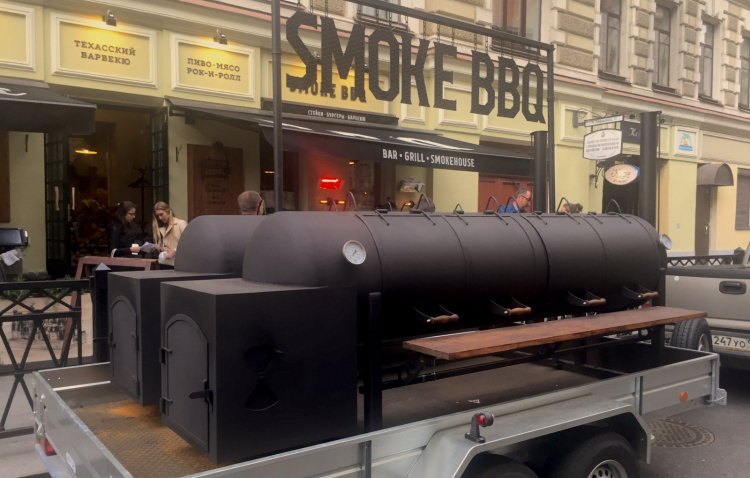It’s quite impressive when you trace a wider and wider spectrum for the fine cuisine virus. It has climbed up to Saint Petersburg, the megalopolis further to the north after Helsinki, which is only a little north in terms of longitude (and a four hours’ drive) but only has 600,000 inhabitants instead of the over 5 millions of the old Leningrad.
We detected traces of good cuisine a few days ago, at the first edition of Gourmet Days, an event that certifies a fact: even Russian authorities have understood the significance of wine and food tourism, the new ally to the white nights, the event that early in the summer attracts hundreds of thousands of tourists to the banks of river Neva.
Sunset after 10 pm, sunrise before 4. In between, in a dusk that never gets completely dark, swarms of people enjoy the light and walk between ulitsa and bars. Traditionally, to drink vodka, but since some time ago they also go out to dine and taste the dishes made by a generation of enthusiastic chefs.
These guys have visited the West, closer than Moscow, attracted by the sirens of fine dining and its mantra: study techniques from the world but then apply them to local products. And what else could they do, given the embargo? Only wines and spirits arrive from Europe, nothing else. «We must make it on our own», is what the wisest entrepreneurs think, a crisis is also a not-to-be-missed chance to awake every producer from the Soviet lethargy that for 70 years (1922-1991) annihilated every initiative.

A mega-barbecue on wheels, in front of restaurant Smoke Bbq, in Ulitsa Rubinshteyna, a popular street at night
Therefore, a fertile dialogue with fishermen from Murmansk is flourishing: they go fishing in the icy waters of the Barents Sea. With lamb breeders from the pastures in Dagestan, on the shore of the Caspian Sea. And there’s even a handful of wine producers who travel between Piedmont or Bourgogne and go back to Crimea and plant Riesling or Barbera grapes (with good results, as in the case of
Pavel Shvets).
Signs of a growing country. Of a spreading pandemic that can be easily noticed in the following nine restaurants.
Big Wine Freaks
Instrumentalnaya Ulitsa, 3
+7.921.9386063
It’s the first to be mentioned but only alphabetically. It’s a wine & champagne bar (with a small kitchen), that gives an idea of how passion for organic Western wines can be a launching pad, especially among the younger and posh people in town. Blasting music to get you to the early morning, perhaps sipping a
Sary Pandas by
Valeriy Zakharyin, local grapes that represent an emancipation from the historic dependence from Georgian wine.
Duo gastrobar
Kirochnaya, 8a
+7.812.9945443
Wood tables, leather sofas, comfortable chairs. A relaxing Russian-industrial setting where to enjoy good ingredient-based cuisine, hinting at global blockbusters: Parmesan mousse, tuna ceviche, gnocchi, risotto…
Gras Madbaren
Inzhenernaya, 7
+7.812.9281818
The chefs young cooks most refer to in Saint Petersburg are
Massimo Bottura and
Renè Redzepi. Young
Anton Abrezov decided to follow the steps of the Danish-Macedonian chef:
Luksus and
Maeemo in his cv and a strong desire for Russia to participate in the
New Nordic Cuisine. Clear inspiration, in terms of aesthetics and sour notes, in dishes like Plate fillet with chickpea purée, spinach and pickled pumpkin.
Hamlet+Jacks
Volynskiy pereulok, 2
+7.812.9070735
Together with the following restaurant, this is the most interesting place for the new cuisine of Saint Petersburg. The concept is opulent, starting from the design, a clear hint to pre-revolution Russia, a time when – they say – local restaurants were the national avantgarde. Yet
Evgeny Vikentev also looks ahead: Carpaccio of Siberian venison, Halibut ravioli, Codfish from Murmansk with apricot sauce, chargrilled aubergines, capelin roe.
Kokoko
Voznesensky prospect, 6
+7.812.4182060
Ivan Grishechkin this is the most creative ace in town. We’ll soon dedicate it a special post.
Moroshka for Pushkin
Naberezhnaya reki Moyki, 3
+7.921.9472500
It’s the most popular luxury place in Saint Petersburg. The welcome cocktail
Blood Sand – whisky Singleton, Vermouth, cherry spirit and orange juice – won’t spoil the meal designed by
Roman Palkin: Beefsteak, smoked beetroot and black garlic; Grilled sturgeon and Sorrel and fresh cheese.
Moroshka means buckthorn. These berries are the emblem of the country. Writer
Aleksandr Pushkin demanded them on his deathbed (hence the name).
Smoke Bbq
Ulitsa Rubinshteyna, 11
+7.812.9055372
30-year-old
Alexey Burov spent 3 years around Texas and South Carolina. The reason: he wanted to learn every barbecue technique in the cradle of barbecues. Six months ago this resulted into a noisy place, in one of the streets with the highest degree of alcohol in town. They serve a surprising American style brisket: high quality beef breast bred in Voronez, hot Cuban pepper and BBQ sauce following the recipe of Texan master
Evan Le Roy.
TarTar Bar
Vilenskiy 15
+7.812.9945443
After gastrobar
Duo,
Dmitry Blinov and
Renat Malikov have set a nice restaurant focused on the double meaning of
Tartar: the Siberian community (once numerous, almost all its members worked in restaurants) and raw fish and meat based dishes. A triumph of offal and intelligent explorations of raw food, from ceviche to carpaccio.
Terrassa
Kazanskaya, 3
+7.812.9376837
One of the many born in the
Ginza Project is this scenic establishment that looks at the Nevskij Prospect and Kazan Cathedral from above. It’s the perfect place where to test the utmost Russian tradition: borscht and sour cream, giant sturgeon,
khachapuri (in fact it was originally from Georgia) and loads of caviar to spread on Russian blinis.